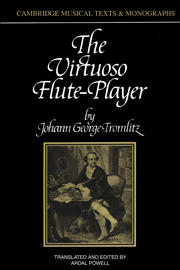Book contents
- Frontmatter
- Contents
- Translator's note
- Introduction by Eileen Hadidian
- Title in the series
- DETAILED AND THOROUGH TUTOR FOR PLAYING THE FLUTE
- Foreword
- Introduction
- 1 The flute and its character
- 2 Holding the flute, and the embouchure
- 3 Fingering
- 4 The notes and rests, their values and denominations, and the other musical signs
- 5 Time-signatures, and how the notes are divided and counted in them; the beat itself, or counting time according to an appointed tempo
- 6 Tone and pure intonation
- 7 Modern key-signatures
- 8 The articulation proper to this instrument, or the means of governing the wind suitably, as well in slow as in moderately quick movements; also called the single tongue
- 9 The technique for executing fast and very fast passages clearly and roundly; also, though improperly, called the ‘double tongue’
- 10 The ornaments
- 11 The trill
- 12 Fermatas and cadenzas
- 13 The taking of breath in flute-playing
- 14 The discretionary ornaments; or how to vary a simple melody according to the rules of harmony, and to use these variations in a good and suitable way appropriate to the material
- 15 Summary of the whole, together with a few remarks for pupils and masters
- Fingering-chart
- Select bibliography
- Index
6 - Tone and pure intonation
Published online by Cambridge University Press: 01 June 2011
- Frontmatter
- Contents
- Translator's note
- Introduction by Eileen Hadidian
- Title in the series
- DETAILED AND THOROUGH TUTOR FOR PLAYING THE FLUTE
- Foreword
- Introduction
- 1 The flute and its character
- 2 Holding the flute, and the embouchure
- 3 Fingering
- 4 The notes and rests, their values and denominations, and the other musical signs
- 5 Time-signatures, and how the notes are divided and counted in them; the beat itself, or counting time according to an appointed tempo
- 6 Tone and pure intonation
- 7 Modern key-signatures
- 8 The articulation proper to this instrument, or the means of governing the wind suitably, as well in slow as in moderately quick movements; also called the single tongue
- 9 The technique for executing fast and very fast passages clearly and roundly; also, though improperly, called the ‘double tongue’
- 10 The ornaments
- 11 The trill
- 12 Fermatas and cadenzas
- 13 The taking of breath in flute-playing
- 14 The discretionary ornaments; or how to vary a simple melody according to the rules of harmony, and to use these variations in a good and suitable way appropriate to the material
- 15 Summary of the whole, together with a few remarks for pupils and masters
- Fingering-chart
- Select bibliography
- Index
Summary
Since tone is a principal component of good performance for instrumentalists as well as for singers, no effort at all should be spared to keep it as beautiful as one possibly can. Everyone knows that a hollow, dull and wooden tone is not correct, and is very detrimental to good delivery. Of course, singers must use the voice that Nature has given them; but even the best voice can be spoiled by forcing it through the nose and between the teeth, or obstructing its normal passage through the throat and mouth. But if an instrumentalist has a bad tone, it is his own fault, for a good sound is entirely the result of his skill; although it is true that a great deal also depends on the instrument. A bad instrument cannot produce a good tone.
Because not all persons are fond of the same kind of tone, but differ amongst themselves in this matter; since one individual likes a strong, full sound, but at the same time not bright and ringing; another likes a strong and shrieking one; still another a thin, biting and sharp one, a fourth a thin and feeble sound, etc., it is therefore impossible to establish a tone-quality that can be recognised as beautiful in general. If the tone is clear, resonant and pleasing, it will indeed please the majority, but there will certainly be some who find something to censure about it here and there.
- Type
- Chapter
- Information
- The Virtuoso Flute-Player , pp. 111 - 134Publisher: Cambridge University PressPrint publication year: 1991



